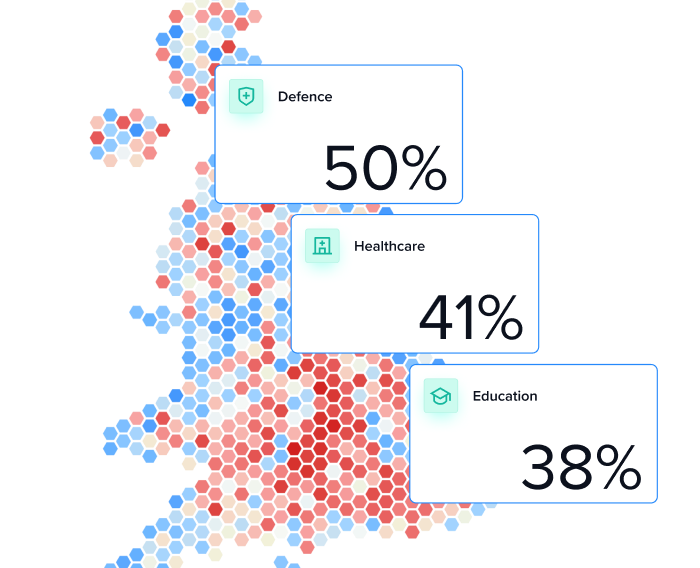Blog/Polling
Can Boris Johnson Recover from a Torrid End to 2021?
Throughout December, we ran polls looking at how Johnson’s government has been affected by weeks of damaging revelations and rising COVID levels. This series culminated in an MRP analysis of the vote intention of 25,000 people to give a constituency-by-constituency breakdown for how the country would vote if an election were held today.
Bleak picture for Boris Johnson and his party
Our December MRP model projected that Labour would win an overall majority of 26 seats. This would mark a reversal from 2019, with the Conservatives dropping by 128 seats and Labour rising by 136.

To put these results into historical context, 237 seats would represent the Conservatives' lowest haul since 2005, and the jump in Labour seats would be surpassed only by the rise in Labour seats seen at the 1997 general election.
Beyond vote intention, other polling we ran in December found that Johnson was falling behind Starmer on key leadership metrics. This is important. Who people see as the best leader has a big bearing on which party they end up voting for.

Starmer not only comes out on top when people were asked who would make the best prime minister out of the two (37% vs 34%). He also outperforms Johnson when it comes to trustworthiness, competency, representing people, and making tough decisions.

The uphill struggle ahead
Johnson and the Conservatives will probably struggle to replicate their 2019 election performance without a major shift in strategy and leadership.
2019 was the “Brexit election”. Post-election analysis from YouGov illustrated how strongly people’s party vote choice was correlated with their EU referendum vote. Their analysis indicated that three-quarters of Leave voters (74%) voted for the Conservatives, with only around one in seven (14%) voting Labour.
Our latest MRP model suggests that this is changing. Party vote choice is decoupling from the 2016 EU referendum. If we look how 2016 Leave voters now split, we can see how different the picture is compared to the 2019 election, with half of Leave voters intending to vote for a party other than the Conservatives.

This is worrying for Johnson. Without being able to rely on a totemic issue like Brexit to drive people to his party, it will be hard to recreate his 2019 success (especially in former Labour heartlands). Our MRP analysis predicts that they lose every Red Wall seat gained in 2019 if an election were held right now.
Crumbs of comfort
However, there is still hope for Johnson. There are signs that a Conservative victory at the next election is not a distant prospect, despite dire recent news coverage.
First, the stark election result that our MRP model predicts is driven more by a Conservative collapse than a Labour surge. Labour vote share does increase compared to 2019, but not to the same degree that the Conservative vote share decreases. Counterintuitively, this should actually give Johnson cause for optimism. Starmer and Labour do not have runaway levels of popularity as Blair and New Labour did in 1997. If Johnson can shake off the scandals that are currently plaguing him, he can recover.
Second, December was a disastrous month for Johnson, with a string of scandals and spiking COVID infections. The stories (and anger) around the scandals will probably subside. Johnson’s poll ratings will probably climb again, albeit slowly. Polls conducted in the heat of scandals (and the whole of December was essentially one long scandal for Johnson) are always liable to reflect temporary public anger rather than permanent voting shifts. There are already signs that this is the case, with the latest January voting intention polls already showing a narrowing of the gap.
Finally, 2019 Conservative voters are over-represented among those who are currently undecided about who they intend to vote for and about who would make the best prime minister. This suggests that Labour’s lead is softer than it looks. As the scandals recede from the media spotlight, it is likely that most of these currently wavering 2019 Conservative voters will return to the party. If they do, the current gap between the parties will close up again.

Looking ahead
Coverage of opinion polling last month spelled out a dire situation for the Conservatives. However, Starmer and Labour have not won over voters yet. Recent public anger and scandals driving voters away from Johsnon will die down. There is a chunk of 2019 Conservative voters who are undecided now but remain up for grabs for Johnson.
If Johnson can steady the ship in 2022, he can steer clear of the disastrous swings in support that our latest MRP modelling predicts. For Starmer and Labour, they cannot rely on Johnson continuing to self-implode to see them through to election success. They have to strengthen their own standing among voters.


